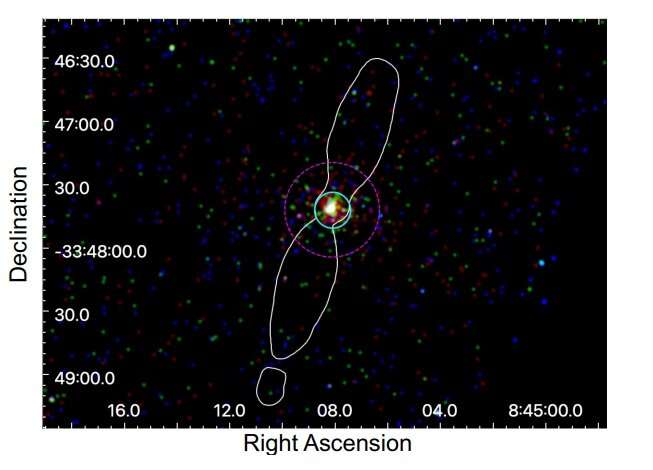Chandra three-color X-ray image of NGC 2663 with ASKAP contours overlaid. Credit: Velović et al., 2022.
An international team of astronomers reports the detection of highly collimated radio jets around a nearby radio galaxy known as NGC 2663. These jets, spanning a total of more than 1,150 light years, could help us improve our knowledge about this galaxy and its surroundings. The finding was detailed July 14 on arXiv.org.
Radio galaxies emit huge amounts of radio waves from their central cores. Black holes at the centers of these galaxies accrete gas and dust, generating high-energy jets visible in radio wavelengths, which accelerate electrically charged particles to high velocities.
At a distance of some 93 million light years away, NGC 2663 (also known as PGC 24590) is an elliptical galaxy with a gaseous disk. It hosts a compact central radio source and previous studies suggested that it also contains an active galactic nucleus (AGN). Although NGC 2663 was detected in 1886 and many observations of this galaxy have been conducted since then, many of its properties still remain unknown.
Therefore, a group of astronomers led by Velibor Velović of Western Sydney University in Australia, has performed a multi-wavelength study of NGC 2663 from radio to X-rays, in order to shed more light on the nature of this galaxy.
"We combine multiwavelength data: radio observations by the Murchison Widefield Array (MWA), the Australian Square Kilometer Array Pathfinder (ASKAP) and the Australia Telescope Compact Array (ATCA), and X-ray data from Chandra, Swift and SRG/eROSITA," the researchers wrote in the paper.
The observations found that NGC 2663 is a large and massive elliptical galaxy with stellar mass of about 580 billion solar masses. Moreover, the study detected two oppositely directed radio jets that extend over 43 arcminutes across the sky, which corresponds to approximately 1,150 light years. This makes NGC 2663 one of the largest radio galaxies (in projected angular size) in the nearby universe.
According to the paper, the radio jets of NGC 2663 have an opening angle of about 30 degrees in the innermost region. After this initial increase in width, they maintain a roughly constant width to the outer regions of the jets. The southern jet has an initial flare as it leaves its host galaxy, at approximately 60 arcseconds from the core.
It was found that in the southern jet there are at least one and plausibly three regions (knots) in which the jet increases significantly in brightness. They resemble similar features as in other AGN jets that are identified as collimation, or recollimation shocks on parsec scales. The astronomers explained that collimation occurs if, for internal or external reasons, the jet becomes cylindrical, traveling with an approximately fixed width, while recollimation takes place when an already collimated jet narrows, rather than merely straightens.
"The southern jet shows at least one possible example of narrowing and simultaneous brightening of the jet. This is possibly indicative of recollimation of the jet by external, environmental pressure. The large recollimation scale (40 kpc) would be consistent with a slow jet in a low pressure environment," the researchers suggested.
The authors of the paper noted that their observations of the jet could also be explained by a jet with variable power. In this scenario, the brightness of the jet is a record of the past activity of the source. However, they added that it is not clear that this would also produce a narrower region of the jet.
More information: Velibor Velović et al, Collimation of the kiloparsec-scale radio jets in NGC 2663. arXiv:2207.06713v1 [astro-ph.GA], arxiv.org/abs/2207.06713
© 2022 Science X Network
























